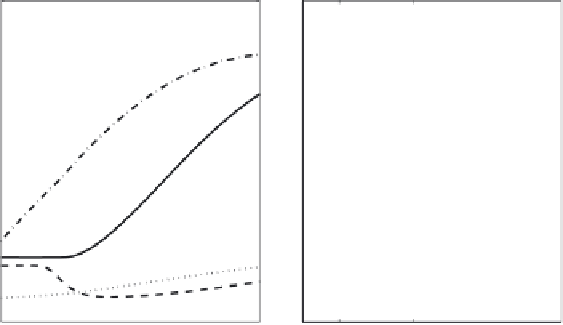Geoscience Reference
In-Depth Information
2
E
0
= 0.5 V/m
Night
γ = 0
15
Day
E
0
= 0.5 V/m
γ = 0
1.5
10
δ Σ
P
, left
1
δ Σ
P
, right
δ Σ
P
, right
5
0.5
δ Σ
P
, left
δ Σ
H
, left
δ Σ
H
, left
δ Σ
H
, right
0
0
δ Σ
H
, right
−0.5
5
2
4
6
8
2
4
6
8
Frequency, MHz
Frequency, MHz
Fig. 13.2.
The dependencies of the relative deviations of
Σ
P
and
Σ
H
against the
frequency of the pump wave for the dayside ionospheric model (left frame) and for
the night ionosphere (right frame). The perturbations are caused by an increase in
T
e
Figure 13.2 shows that
δΣ
H
is negative in both models as for the right
(dashed line) as for the left polarized (dotted line) pump waves.
δΣ
H
are
of the order of tenths of percent in the daytime and less than 1% in the
nighttime.
δΣ
P
are greater and
15% in the
nighttime.
Σ
P
grows with
ω
in the daytime and decreases in the nighttime.
By day, the counterclockwise polarized mode causes stronger perturbations
of
Σ
P
than the clockwise polarized mode. In the afternoon, the left-handed
wave leads to greater perturbation of
Σ
P
than the right-handed wave. a wave.
At night, on the contrary, the right-handed wave causes greater perturbations
of
Σ
P
. Switch from night to day decreases the heating effect by exponent of
magnitude because of strong attenuation in the lower ionosphere with a fairly
small contribution to the total conductivity.
These and others similar calculations demonstrated that we should not
expect the maximum absolute deviation in the existing current systems to
exceed 1% in the daytime and 15% in the nighttime when the effective power
of an equivalent dipole is
∼
1
−
2% in the daytime and
∼
10
−
10
3
MW. The low daytime
δΣ
P
and
δΣ
H
would
be expected with simple arguments. The portion of energy lost at elastic col-
lisions is approximately equal to the ratio of masses of the colliding particles.
Therefore the main heated component is the electron gas.
Since mainly the electrons are the heating, the deviations of the conduc-
tivities are due to
β
e
,
then (see (1.93), 1.94))
≈
δσ
P
=
δσ
Pe
,
δ
H
=
δσ
He
,
(13.4)
β
e
1+
β
e
σ
Pe
=
c
Ne
B
0
β
e
1+
β
e
He
=
c
Ne
B
0
,
,
(13.5)


























Search WWH ::

Custom Search